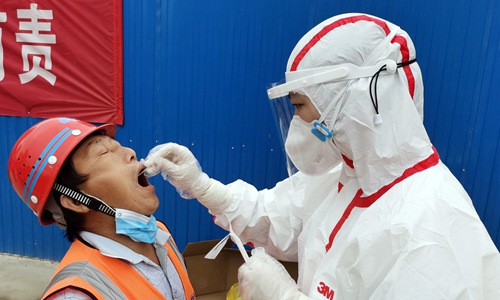Wuhan verified safe from epidemic after citywide test results prove victory: chief epidemiologist

A medical worker with the Hanyang district center of disease control takes a throat swab sample for a COVID-19 nucleic acid test from a construction worker on Thursday in Wuhan, Central China's Hubei Province. The tests will enhance public health security as the city resumes production. Photo: cnsphoto
Wuhan, capital of Central China's Hubei Province and the city hit hardest by the COVID-19 epidemic, said on Monday that all 300 asymptomatic carriers discovered in the latest citywide tests showed negative viral culture test results. The findings were a loud declaration of the city's glorious victory against the virus after months of tough battles as they proved that the city is just as safe as other parts of China and another large-scale community infection is very unlikely to occur anywhere in the country, Chinese chief epidemiologist said on Tuesday.
Wuhan health officials took sputum and throat swabs from 300 asymptomatic carriers and then isolated and cultured the "virus" from the samples at the Wuhan Institute of Virology, Chinese Academy of Sciences. The results found no "live virus" in the samples.
Wu Zunyou, chief epidemiologist at the Chinese Center for Disease Control and Prevention, told the Global Times on Tuesday that this indicated that the viral loads and levels were either extremely low or that there was no presence of any "live virus" within the pathogensis of the samples taken.
Officials also ran tests on toothbrushes, cups, masks, towels, and other personal items used by the infected patients, and found that they tested negative. All 1,174 close contacts of the patients tested negative, which experts said proved that the city's silent carriers are not contagious any more.
"Wuhan's scientific and profound probe into the group of carriers is innovative and valuable, and will help us better understand the course of the COVID-19," Wu said.
It is reasonable to conclude that the city is "very safe, just as safe as other parts of the country," and with sound and complete epidemic control and prevention measures that China has established and constantly improved, "another large-scale community infection is very unlikely to occur anywhere in the country, despite individual imported cases," Wu noted.
Meanwhile, the test results don't indicate that all silent carriers are not contagious. "We should understand that those showing a positive result in the nucleic acid tests could be either carrying live virus or only part of the virus that possesses no infectivity, which is the case with the Wuhan 300 carriers," Wu stressed.
Commenting on foreign media reports questioning the low number of asymptomatic carriers detected in Wuhan, Wu said the data is completely authentic and there has been no concealment or under-reporting.
"There has not been a community-level outbreak outside Hubei Province, and even within Wuhan, community infection was strictly controlled at the early stage. Cluster infections were only discovered at individual households and hospitals," Wu explained.
However, people must be aware that 95 percent of Wuhan residents and 99 percent of Chinese population are still considered as "susceptible groups" for the novel coronavirus infection, so a high level of alertness should be maintained, Wu urged.
Also on Monday, the Civil Aviation Administration of China said that Wuhan was added as a standby first entry point for international flights to Beijing.
Flights between Wuhan and Beijing resumed on Tuesday, which include one daily round-trip flight from Wuhan Tianhe Airport to Beijing Daxing International Airport, according to Wuhan's traffic authority.
The daily direct flight connecting Wuhan and Beijing will run until June 27, at which point routes would become more frequent according to the epidemic control situation and passengers' requests, said a spokesperson with the Hubei branch of Southern China Airlines, the operator of the route.
The first direct flight from Wuhan was scheduled to land in Beijing at 6:05 pm on Tuesday. The return trip was set to leave Beijing by 7:15 pm and arrive in Wuhan by 9:40 pm, Global Times learned.
These developments show that Wuhan can resume normal exchanges with the outside world and increase its recovery pace as it returns to normal, experts said.


